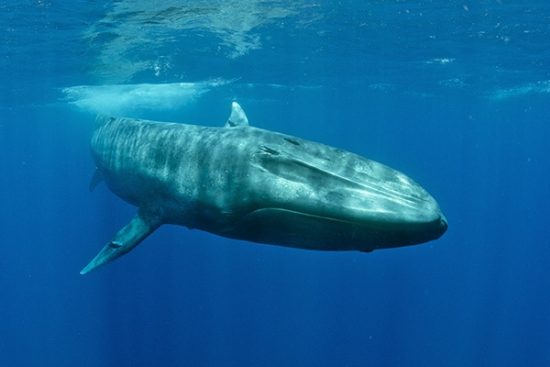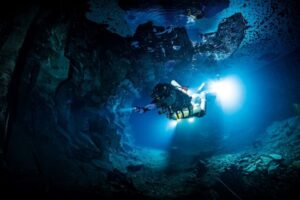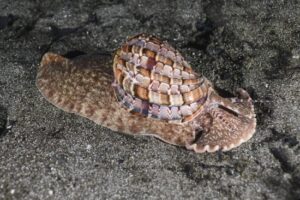
The southern coast of Sri Lanka may turn out to be one of the best international hotspots for seeing blue whales.
Blue whales (Balaenoptera musculus) are the largest animals ever to have lived on Earth, bigger even than the largest of the dinosaurs. These jumbo-jet-sized giants (up to 33 metres long and weighing up to 180 tons) inhabit the open ocean, where they are found most frequently along continental shelf edges and near polar ice.
There are some sub-species of blue whales. Those living in the water off Sri Lanka may be a sub-species (Balaenoptera musculus indica) of the Pygmy blue whale or Southern Hemisphere subspecies (Balaenoptera musculus brevicauda).
Imagine being on a small boat, only three people plus the skipper, 10 kilometres from the nearest coast, looking for blue whales whose length can reach up to 25m (making them 5m shorter than the Antarctic species and half a meter shorter than the pygmy blue whales that live in the southern Indian Ocean). These encounters will make you feel really small and vulnerable, but you have nothing to fear from the gentle giant surfacing every twelve to fifteen minutes for a breath of air.
As long as we are gentle and our swimming is calm in the water, whales usually accept our presence with them; when they are annoyed, they easily plunge to the depths, leaving us at the surface. It is a great privilege to swim side by side with such huge animals and look directly in their eyes: it is something breathtaking.
In-water activities with whales (snorkelling, swimming, taking pictures or videos) are possible only with the authorisation of the Government. It is quite difficult to achieve this special permit because Sri Lanka’s authorities are strict regarding conservation: permits are released only after a meticulous process of examination of requirements. The welfare of whales is not compromised. Even the drivers of the whale-watching vessels are extensively trained and they will never rush up to the animals (and up to you) and create stress.
We do not have to fear these majestic animals, but we cannot say the same for the whales. Like other whale species, blue whales were once hunted near to extinction by whalers who killed them to make products such as lamp oil and whale bone corsets. Blue whale hunting was banned in 1966 by the International Whaling Commission and illegal whaling by the Soviet Union finally halted in the 1970s, by which time 330,000 blue whales had been caught in the Antarctic, 33,000 in the rest of the Southern Hemisphere, 8,200 in the North Pacific and 7,000 in the North Atlantic. The largest original population, in the Antarctic, had been reduced to a mere 360 individuals, about 0.15% of their initial numbers. They became so scarce that whalers turned to other species, but blue whales have not since recovered their former numbers. Today, the greater challenges facing blue whales all over the world are being struck by shipping vessels or tangled in fishing gear, micro-plastic-chemical and noise pollution and metal contaminants.
In Sri Lanka there is a large, mostly unstudied population of blue whales, possibly numbering in the thousands. Studies of marine mammal identification, distribution and abundance were carried out in the early 1980s, but these offshore research programmes came to a halt in 1985 due to the Singhalese/Tamil civil war. At the end of the war (May 2009), interest in the status of marine mammals off the coast of Sri Lanka returned, as well as understanding the conservation challenges unique to the country.
The concentration of these blue whales off the southern coast of Sri Lanka aggregates around one of the busiest shipping lanes in the world. Much of this area is characterised by submarine canyons and sloping bathymetry which contributes to monsoonal seasons of high productivity and upwelling suitable for feeding whales. But this same area has come under increasing pressure from a boom in whale-watching boats, mostly from December to April because during these months the wind and seas are generally calm and the level of tourism ensures reliable business. From May to October the southwest monsoon brings rough weather not conducive to whale-watching and tourism remains low during November.
Sri Lanka’s blue whales don’t seem to migrate to polar waters, and there are individuals resident around Sri Lanka all year round. They feed and give birth in the warm, tropical waters and they have a different call to other populations, so are acoustically identifiable.
NOTE: Diving, freediving, snorkelling and swimming with whales is forbidden in Sri Lanka’s waters. To do this, you need a special permit issued by the Government, and must rely on one permitted boat operator. The permit is released only for research programmes and photo-identification. All our images were taken under that permit!
The post The largest animals ever to have lived on Earth! appeared first on Mares – Scuba Diving Blog.
Read MoreDiving, blue whale, climate change, conservation, freediving, Mares, ocean, photography, research, Sri Lanka, underwater, whaleMares – Scuba Diving Blog



